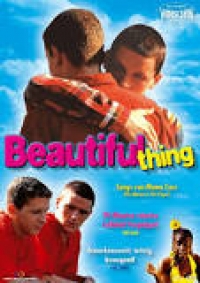„The beautiful thing” (1996) directed by Hettie Macdonald
Krzysztof Orlikowski
Cele lekcji
– To raise students’ awareness of social problems of homosexuality and tolerance
– To develop students’ ability to analyse movie content critically
– To improve students’ speaking and discussion skills
– To improve students’ cooperation
– To allow students to enjoy themselves and be creative
– To give students access to English used in a specific context
– To enrich students’ worldviews
Czas pracyFilm screening: 90 minutes, 2×45 minutes lessons Środki dydaktyczne
|
Formy pracy
Metody pracy
|
Przebieg lekcji
1. Introduction to the topic
The teacher writes the word „Love” on the blackboard and asks the students to think of their own definition of this notion. The teacher elicits answers from the students and asks volunteers to write down their definitions on the whiteboard. After they have finished, the teacher writes the following on the whiteboard „Love is affection shared by two people.” The students are then asked to comment on this statement (how they understand it and what it means to them). After they have finished, the teacher hangs pictures of homosexual couples on the whiteboard and asks the students to describe what they see. After a brief discussion, the teacher hangs different pictures, now of heterosexual couples, below the homosexual ones, and writes equality („=”) sign on the whiteboard. Next, the teacher asks the students whether the same definition of love applies to all of the couples presented and whether there is any difference between the pictures presented. When the students have expressed their opinions, the teacher then asks how it is seen by society, whether the same definitions still apply, and whether society views the feelings shared by both groups as equal or differently?
2. Homosexuals in contemporary culture
The teacher gives the students a set of pictures with heterosexual people as well as homosexual people from contemporary culture and the last century e.g. Neil Patrick Harrison, Freddy Mercury, Ian McKellen etc. The students have to work in groups to categorize those pictures according to simple criteria: heterosexuals and homosexuals. When using pictures of heterosexual people, it would be advisable to present people who may seem or appear to be homosexual to increase the difficulty of the task. The reverse can be applied to homosexual people – using pictures of people who look straight.
After the students have finished, the teacher elicits answers, asking for their criteria for deciding who is homosexual and who is heterosexual. The students are asked to explain why they grouped the photographs the way they did. After this task is finished, the teacher presents the proper grouping of those pictures and shows the students how correct they were. The follow-up is a discussion: is it really important to know the sexual orientation of a person? Does it influence how we relate to a person? What problems can it create (e.g. difficulty finding a job, ostracism, etc.)? What problems were faced by the characters in the movie? How could they be resolved?
[This concludes the first lesson- it would be best if the second lesson followed immediately]
3. Tolerance
The teacher reminds the students what the previous lesson was about (if the lessons are not consecutive). The teacher asks the students to come up with the definition of tolerance (in small groups). Then, the definitions are hung on the board- what was similar in all of them? What was different? Then, the teacher asks which groups usually have to face intolerance and why. What groups where indicated by the movie (e.g. a singer in the bar- drag queen)? Then, the groups have to think of a social campaign that could raise tolerance in Poland. What the themes should be?; what medium they would choose (posters, TV ads, etc.)? Then, the groups present their ideas to the class.
4. Domestic problems
What were other problems raised in the movie? Guided discussion for students to talk about such domestic problems as beating, lack of a parent, drugs. Was homosexuality the biggest issue of in the movie? Then, the students (in pairs) have to come up with solutions to some problems depicted in the movie (how they would react, e.g. they see that their friend got bruises or is using drugs, etc.). The situations are on the handouts given out by the teacher.
5. Roleplay
The students are given a description of a problematic situation. Each group has a different one. They have to re-enact the situation and come up with a solution (e.g. two students are the parents in a traditional Polish family, their son comes home with his boyfriend- what are possible reactions of the parents? what would they do?; a single mom finds drugs in her daughter’s room- should she confront the daughter or hide the fact, etc.?). The situations are enacted for the whole class and each „play” is followed by a short discussion: what could have been done differently? was the outcome was realistic or not, etc.?
6. Summing up project
As the last activity, the students are asked to create a project connected with the issues discussed during the lessons – homosexuality, domestic problems, drugs and tolerance. They can work in groups and are free to choose the form of the project. The teacher can guide them, giving the students some ideas for the project, e.g. create a poster which raises awareness of homosexuality; record a short clip presenting the students’ attitude towards tolerance; draw a short comic or write an essay on the topic which can be posted in the classroom or published on the internet. If some of the students need more time to finish their project, they can be allowed to do it at home. After the students have finished, they present the project to the whole class. This can be done at beginning of the next lesson or during a time arranged between the students and the teacher if it is necessary.


